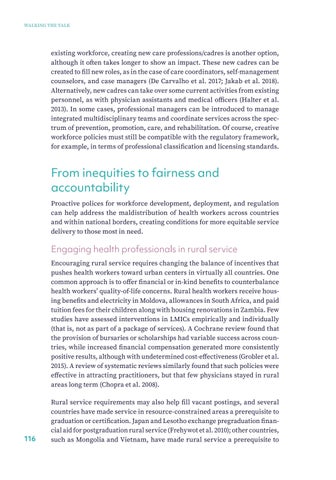WALKING THE TALK
existing workforce, creating new care professions/cadres is another option, although it often takes longer to show an impact. These new cadres can be created to fill new roles, as in the case of care coordinators, self-management counselors, and case managers (De Carvalho et al. 2017; Jakab et al. 2018). Alternatively, new cadres can take over some current activities from existing personnel, as with physician assistants and medical officers (Halter et al. 2013). In some cases, professional managers can be introduced to manage integrated multidisciplinary teams and coordinate services across the spectrum of prevention, promotion, care, and rehabilitation. Of course, creative workforce policies must still be compatible with the regulatory framework, for example, in terms of professional classification and licensing standards.
From inequities to fairness and accountability Proactive polices for workforce development, deployment, and regulation can help address the maldistribution of health workers across countries and within national borders, creating conditions for more equitable service delivery to those most in need.
Engaging health professionals in rural service Encouraging rural service requires changing the balance of incentives that pushes health workers toward urban centers in virtually all countries. One common approach is to offer financial or in-kind benefits to counterbalance health workers’ quality-of-life concerns. Rural health workers receive housing benefits and electricity in Moldova, allowances in South Africa, and paid tuition fees for their children along with housing renovations in Zambia. Few studies have assessed interventions in LMICs empirically and individually (that is, not as part of a package of services). A Cochrane review found that the provision of bursaries or scholarships had variable success across countries, while increased financial compensation generated more consistently positive results, although with undetermined cost-effectiveness (Grobler et al. 2015). A review of systematic reviews similarly found that such policies were effective in attracting practitioners, but that few physicians stayed in rural areas long term (Chopra et al. 2008).
116
Rural service requirements may also help fill vacant postings, and several countries have made service in resource-constrained areas a prerequisite to graduation or certification. Japan and Lesotho exchange pregraduation financial aid for postgraduation rural service (Frehywot et al. 2010); other countries, such as Mongolia and Vietnam, have made rural service a prerequisite to


